Contamination and Probabilistic Ecological–Health Risk of Heavy Metal(loid)s in Urban Topsoil of Mianyang, SW China
Abstract
1. Introduction
2. Materials and Methods
2.1. Study Area
2.2. Sampling and Monitoring
2.3. Data Analysis
2.3.1. Geo-Accumulation Index (Igeo)
2.3.2. Potential Ecological Risk Index (RI)
2.3.3. Health Risk Assessment
2.3.4. Monte Carlo Simulation (MCS)
3. Results and Discussion
3.1. Content of HMs in Topsoil
| HMs | As | Ba | Cr | Co | Cu | Ni | Pb | Mn | Zn | V |
|---|---|---|---|---|---|---|---|---|---|---|
| Mean | 11.2 | 586.8 | 124.7 | 20.2 | 37.8 | 34.9 | 28.4 | 661.5 | 102.2 | 96.6 |
| Minimum | 3.0 | 292.3 | 72.0 | 7.4 | 16.7 | 16.7 | 16.6 | 71.6 | 40.0 | 42.8 |
| Maximum | 30.0 | 873.4 | 252.0 | 93.9 | 369.9 | 49.6 | 60.0 | 1356.9 | 320.2 | 155.5 |
| SD | 4.2 | 110.9 | 28.9 | 12.5 | 34.6 | 5.6 | 7.1 | 168.6 | 39.0 | 15.8 |
| CV (%) | 37.6 | 18.9 | 23.2 | 62.0 | 91.6 | 16.2 | 24.9 | 25.5 | 38.2 | 16.4 |
| Reference value [32] | 10.4 | 474.0 | 79.0 | 17.6 | 31.1 | 32.6 | 30.9 | 657.0 | 86.5 | 96.0 |
| Havana [43] | NA | NA | NA | 9.2 | 10.3 | 25.6 | 56.0 | NA | 104.0 | NA |
| Medak [44] | 4.4 | NA | 244.1 | NA | 63.6 | 20.2 | 24.7 | NA | 58.8 | NA |
| Vigo [45] | NA | 516.8 | 68.6 | NA | 66.1 | 32.0 | 96.3 | 531.6 | 149.0 | NA |
| Ancona [46] | NA | NA | 45.6 | 18.1 | 63.9 | 50.9 | 97.4 | NA | 199.1 | NA |
| Yan’an [47] | NA | NA | 66.2 | NA | 23.7 | 37.6 | 20.2 | NA | 71.2 | NA |
| Xi’an [48] | NA | NA | 81.1 | 19.3 | 54.3 | 34.5 | 59.7 | 671.5 | 186.2 | 85.2 |
| Ningbo [5] | 7.2 | NA | 80.0 | NA | 39.9 | 32.1 | 51.4 | NA | 122.6 | NA |
| Shanghai [14] | 8.1 | NA | 101.6 | NA | 36.7 | 38.5 | 38.3 | 717.6 | 152.7 | NA |
| Beijing [15] | NA | NA | 61.0 | NA | 31.7 | 24.0 | 23.3 | NA | 92.9 | NA |
| Karamay [19] | 20.7 | NA | 117.9 | NA | 64.2 | 42.7 | 32.6 | NA | 123.3 | NA |
3.2. Hot Spot Analysis of HMs in Topsoil
3.3. Results of Geo-Accumulation Assessment
3.4. Results of Potential Ecological Risk Assessment
3.4.1. Potential Ecological Risk Factor of Individual HMs (Ei) and Potential Ecological Risk Index (RI) of All HMs
3.4.2. Assessment of Potential Ecological Risk Based on MCS
3.5. Concentration-Oriented Human Health Risk Assessment
3.5.1. Human Health Risk Assessment
3.5.2. Assessment of Human Health Risk Based on MCS
3.6. Source-Oriented Human Health Risk Assessment
4. Conclusions
Supplementary Materials
Author Contributions
Funding
Institutional Review Board Statement
Informed Consent Statement
Data Availability Statement
Acknowledgments
Conflicts of Interest
References
- Keshavarzi, A.; Kumar, V.; Ertunç, G.; Brevik, E.C. Ecological risk assessment and source apportionment of heavy metals contamination: An appraisal based on the Tellus soil survey. Environ. Geochem. Health 2021, 43, 2121–2142. [Google Scholar] [CrossRef] [PubMed]
- Gamiño-Gutiérrez, S.P.; González-Pérez, C.I.; Gonsebatt, M.E.; Monroy-Fernández, M.G. Arsenic and lead contamination in urban soils of Villa de la Paz (Mexico) affected by historical mine wastes and its effect on children’s health studied by micronucleated exfoliated cells assay. Environ. Geochem. Health 2013, 35, 37–51. [Google Scholar] [CrossRef] [PubMed]
- Pan, L.; Ma, J.; Hu, Y.; Su, B.; Fang, G.; Wang, Y.; Wang, Z.; Wang, L.; Xiang, B. Assessments of levels, potential ecological risk, and human health risk of heavy metals in the soils from a typical county in Shanxi Province, China. Environ. Sci. Pollut. Res. 2016, 23, 19330–19340. [Google Scholar] [CrossRef] [PubMed]
- Moturi, M.C.Z.; Rawat, M.; Subramanian, V. Distribution and fractionation of heavy metals in solid waste from selected sites in the industrial belt of Delhi, India. Environ. Monit. Assess. 2004, 95, 183–199. [Google Scholar] [CrossRef]
- Xiang, M.; Li, Y.; Yang, J.; Li, Y.; Li, F.; Hu, B.; Cao, Y. Assessment of heavy metal pollution in soil and classification of pollution risk management and control zones in the industrial developed city. Environ. Manag. 2020, 66, 1105–1119. [Google Scholar] [CrossRef]
- Mathur, R.; Balaram, V.; Satyanarayanan, M.; Sawant, S.S. Assessment of heavy metal contamination of road dusts from industrial areas of Hyderabad, India. Environ. Monit. Assess. 2016, 188, 514. [Google Scholar] [CrossRef]
- Sellami, S.; Zeghouan, O.; Dhahri, F.; Mechi, L.; Moussaoui, Y. Assessment of heavy metal pollution in urban and peri-urban soil of Setif city (High Plains, eastern Algeria). Environ. Monit. Assess. 2022, 194, 126. [Google Scholar] [CrossRef]
- Enyoh, C.E.; Isiuku, B.O. Determination and human health risk assessment of heavy metals in floodbasin soils in Owerri, southeastern Nigeria. Chem. Afr. 2020, 3, 1059–1071. [Google Scholar] [CrossRef]
- Johri, N.; Jacquillet, G.; Unwin, R. Heavy metal poisoning: The effects of cadmium on the kidney. Biometals 2010, 23, 783–792. [Google Scholar] [CrossRef]
- Kamani, H.; Mahvi, A.H.; Seyedsalehi, M.; Jaafari, J.; Hoseini, M.; Safari, G.H.; Dalvand, A.; Aslani, H.; Mirzaei, N.; Ashrafi, S.D. Contamination and ecological risk assessment of heavy metals in street dust of Tehran, Iran. Int. J. Environ. Sci. Technol. 2017, 14, 2675–2682. [Google Scholar] [CrossRef]
- Lin, M.; Gui, H.; Wang, Y.; Peng, W. Pollution characteristics, source apportionment, and health risk of heavy metals in street dust of Suzhou, China. Environ. Sci. Pollut. Res. 2017, 24, 1987–1998. [Google Scholar] [CrossRef] [PubMed]
- Demirak, A.; Kocakaya, M.; Keskin, F. Chemical fractions of toxic metals and assessment of risks on the environment and health in Mugla topsoils. Int. J. Environ. Sci. Technol. 2021, 19, 5631–5648. [Google Scholar] [CrossRef]
- Rahmani, F.; Jafarian, A.; Lak, R.; Ismaili, J. Urban and agricultural environmental geochemistry and identification of heavy metals in the soil of Sari City (Mazandaran Province, Iran). Int. J. Environ. Sci. Technol. 2022, 19, 6251–6266. [Google Scholar] [CrossRef]
- Li, Y.; Yuan, Y.; Sun, C.; Sun, T.; Liu, X.; Li, J.; Fang, L.; Fan, Z. Heavy metals in soil of an urban industrial zone in a metropolis: Risk assessment and source apportionment. Stoch. Environ. Res. Risk Assess. 2020, 34, 435–446. [Google Scholar] [CrossRef]
- Wang, M.; Markert, B.; Chen, W.; Peng, C.; Ouyang, Z. Identification of heavy metal pollutants using multivariate analysis and effects of land uses on their accumulation in urban soils in Beijing, China. Environ. Monit. Assess. 2012, 184, 5889–5897. [Google Scholar] [CrossRef] [PubMed]
- Yang, Z.; Lu, W.; Long, Y.; Bao, X.; Yang, Q. Assessment of heavy metals contamination in urban topsoil from Changchun City, China. J. Geochem. Explor. 2011, 108, 27–38. [Google Scholar] [CrossRef]
- Han, X.; Li, H.; Su, M.; An, P. Spatial network analysis of surface soil pollution from heavy metals and some other elements: A case study of the Baotou region of China. J. Soils Sediments 2019, 19, 629–640. [Google Scholar] [CrossRef]
- Zong, Y.; Qing, X.; Lu, S. Distribution, bioavailability, and leachability of heavy metals in soil particle size fractions of urban soils (northeastern China). Environ. Sci. Pollut. Res. 2016, 23, 14600–14607. [Google Scholar]
- Wang, W.; Lai, Y.; Ma, Y.; Liu, Z.; Wang, S.; Hong, C. Heavy metal contamination of urban topsoil in a petrochemical industrial city in Xinjiang, China. J. Arid Land 2016, 8, 871–880. [Google Scholar] [CrossRef]
- Du, H.; Lu, X. Spatial distribution and source apportionment of heavy metal(loid)s in urban topsoil in Mianyang, Southwest China. Sci. Rep. 2022, 12, 10407. [Google Scholar] [CrossRef]
- Kim, H.; Lee, M.; Lee, J.H.; Kim, K.H.; Owens, G.; Kim, K.R. Distribution and extent of heavy metal(loid) contamination in agricultural soils as affected by industrial activity. Appl. Biol. Chem. 2020, 63, 31. [Google Scholar] [CrossRef]
- Jun, R.; Wei, H. Research on Mianyang positioning and economic development strategy in Chengdu-Chongqing double city economic circle. Can. Soc. Sci. 2021, 17, 1–5. [Google Scholar]
- Zhang, Y.; He, Z.; Tian, H.; Huang, X.; Zhang, Z.; Liu, Y.; Xiao, Y.; Li, R. Hydrochemistry appraisal, quality assessment and health risk evaluation of shallow groundwater in the Mianyang area of Sichuan Basin, southwestern China. Environ. Earth Sci. 2021, 80, 576. [Google Scholar] [CrossRef]
- NBSPRC (National Bureau of Statistics of the People’s Republic of China). China City Statistical Yearbook; China Statistics Press: Beijing, China, 2020; pp. 1–32. (In Chinese) [Google Scholar]
- Han, X.; Lu, X.; Zhang, Q.; Wuyuntana; Hai, Q.; Pan, H. Grain-size distribution and contamination characteristics of heavy metal in street dust of Baotou, China. Environ. Earth Sci. 2016, 75, 468. [Google Scholar] [CrossRef]
- Yang, Y.; Christakos, G. Uncertainty assessment of heavy metal soil contamination mapping using spatiotemporal sequential indicator simulation with multi-temporal sampling points. Environ. Monit. Assess. 2015, 187, 571. [Google Scholar] [CrossRef]
- Chen, X.; Lu, X. Contamination characteristics and source apportionment of heavy metals in topsoil from an area in Xi’an city, China. Ecotoxicol. Environ. Saf. 2018, 151, 153–160. [Google Scholar] [CrossRef]
- Zhuang, S.; Lu, X.; Yu, B.; Fan, X.; Yang, Y. Ascertaining the pollution, ecological risk and source of metal(loid)s in the upstream sediment of Danjiang River, China. Ecol. Indic. 2021, 125, 107502. [Google Scholar] [CrossRef]
- Soltani-Gerdefaramarzi, S.; Ghasemi, M.; Gheysouri, M. Pollution, human health risk assessment and spatial distribution of toxic metals in urban soil of Yazd City, Iran. Environ. Geochem. Health 2021, 43, 3469–3484. [Google Scholar] [CrossRef]
- Liu, D.; Li, Y.; Ma, J.; Li, C.; Chen, X. Heavy metal pollution in urban soil from 1994 to 2012 in Kaifeng City, China. Water Air Soil Pollut. 2016, 227, 154. [Google Scholar] [CrossRef]
- Müller, G. Index of geoaccumulation in sediments of the Rhine River. GeoJournal 1969, 2, 109–118. [Google Scholar]
- CNEMC (China National Environmental Monitoring Centre). The Background Values of Elements in Chinese Soils; Environmental Science Press of China: Beijing, China, 1990; pp. 329–493. (In Chinese) [Google Scholar]
- Håkanson, L. An ecological risk index for aquatic pollution control a sedimentological approach. Water Res. 1980, 14, 975–1001. [Google Scholar] [CrossRef]
- Fan, X.; Lu, X.; Yu, B.; Zuo, L.; Fan, P.; Yang, Y.; Zhuang, S.; Liu, H.; Qin, Q. Risk and sources of heavy metals and metalloids in dust from university campuses: A case study of Xi’an, China. Environ. Res. 2021, 202, 111703. [Google Scholar] [CrossRef] [PubMed]
- Lu, X.; Wu, X.; Wang, Y.; Chen, H.; Gao, P.; Fu, Y. Risk assessment of toxic metals in street dust from a medium-sized industrial city of China. Ecotoxicol. Environ. Saf. 2014, 106, 154–163. [Google Scholar] [CrossRef] [PubMed]
- Huang, J.; Wu, Y.; Sun, J.; Li, X.; Geng, X.; Zhao, M.; Sun, T.; Fan, Z. Health risk assessment of heavy metal(loid)s in park soils of the largest megacity in China by using Monte Carlo simulation coupled with Positive matrix factorization model. J. Hazard. Mater. 2021, 415, 125629. [Google Scholar] [CrossRef]
- USEPA (United States Environmental Protection Agency). OSWER 9355.4–24 Supplemental Guidance for Developing Soil Screening Level for Superfund Sites; Office of Emergency and Remedial Response: Washington, DC, USA, 2002; pp. 1–187. [Google Scholar]
- Van den Berg, R. Human Exposure to Soil Contamination: A Qualitative and Quantitative Analysis towards Proposals for Human Toxicological Intervention Values (RIVM Report no. 725201011); National Institute of Public Health and Environmental Protection (RIVM): Bilthoven, The Netherlands, 1995. [Google Scholar]
- MEPPRC (Ministry of Environmental Protection of the People’s Republic of China). HJ 25.3—2019 Technical Guidelines for Risk Assessment of Soil Contamination of Land for Construction; Ministry of Ecology and Environment: Beijing, China, 2019; pp. 1–53. (In Chinese) [Google Scholar]
- USEPA (United States Environmental Protection Agency). EPA/540/R95/128 Soil Screening Guidance: Technical Background Document; Office of Solid Waste and Emergency Response: Washington, DC, USA, 1996; pp. 18–22. [Google Scholar]
- Zhao, X.; Duan, X. Highlights of the Chinese Exposure Factors Handbook (Adults); China Environmental Science Press: Beijing, China, 2014; p. 64. (In Chinese) [Google Scholar]
- Yu, E.; Liu, H.; Dinis, F.; Zhang, Q.; Jing, P.; Liu, F.; Ju, X. Contamination evaluation and source analysis of heavy metals in karst soil using UNMIX model and Pb-Cd isotopes. Int. J. Environ. Res. Public Health 2022, 19, 12478. [Google Scholar] [CrossRef]
- Rizo, O.D.; Castillo, F.E.; López, J.O.A.; Merlo, M.H. Assessment of heavy metal pollution in urban soils of Havana city, Cuba. Bull. Environ. Contam. Toxicol. 2011, 87, 414. [Google Scholar] [CrossRef]
- Adimalla, N. Heavy metals contamination in urban surface soils of Medak Province, India, and its risk assessment and spatial distribution. Environ. Geochem. Health 2020, 42, 59–75. [Google Scholar] [CrossRef]
- Rodríguez-Seijo, A.; Andrade, M.L.; Vega, F.A. Origin and spatial distribution of metals in urban soils. J. Soils Sediments 2017, 17, 1514–1526. [Google Scholar] [CrossRef]
- Serrani, D.; Ajmone-Marsan, F.; Corti, G.; Cocco, S.; Cardelli, V.; Adamo, P. Heavy metal load and effects on biochemical properties in urban soils of a medium-sized city, Ancona, Italy. Environ. Geochem. Health 2022, 44, 3425–3449. [Google Scholar] [CrossRef]
- Hu, Y.; Wang, D.; Wei, L.; Song, B. Heavy metal contamination of urban topsoils in a typical region of Loess Plateau, China. J. Soils Sediments 2014, 14, 928–935. [Google Scholar] [CrossRef]
- Chen, X.; Lu, X.; Li, L.Y.; Yang, G. Spatial distribution and contamination assessment of heavy metals in urban topsoil from inside the Xi’an second ringroad, NW China. Environ. Earth Sci. 2013, 68, 1979–1988. [Google Scholar] [CrossRef]
- Moghtaderi, T.; Alamdar, R.; Rodríguez-Seijo, A.; Naghibi, S.J.; Kumar, V. Ecological risk assessment and source apportionment of heavy metal contamination in urban soils in Shiraz, Southwest Iran. Arab. J. Geosci. 2020, 13, 797. [Google Scholar] [CrossRef]
- Bati, Z.A.; Altun, S. Investigation of the effect of barium-based additive on smoke and NOx emissions of a diesel engine fueled with conventional and biodiesel fuels. Clean Technol. Environ. Policy 2020, 22, 1285–1295. [Google Scholar] [CrossRef]
- Chen, H.; Lu, X.; Li, L.Y.; Gao, T.; Chang, Y. Metal contamination in campus dust of Xi’an, China: A study based on multivariate statistics and spatial distribution. Sci. Total Environ. 2014, 484, 27–35. [Google Scholar] [CrossRef] [PubMed]
- Liu, Y.; Huang, H.; Sun, T.; Yuan, Y.; Pan, Y.; Xie, Y.; Fan, Z.; Wang, X. Comprehensive risk assessment and source apportionment of heavy metal contamination in the surface sediment of the Yangtze River Anqing section, China. Environ. Earth Sci. 2018, 77, 493. [Google Scholar] [CrossRef]
- Pavlović, D.; Pavlović, M.; Čakmak, D.; Kostić, O.; Jarić, S.; Sakan, S.; Đorđević, D.; Mitrović, M.; Gržetić, I.; Pavlović, P. Fractionation, mobility, and contamination assessment of potentially toxic metals in urban soils in four industrial Serbian cities. Arch. Environ. Contam. Toxicol. 2018, 75, 335–350. [Google Scholar] [CrossRef]
- Chen, X.; Lu, X. Contamination characteristics and source apportionment of potentially toxic elements in the topsoil of Huyi District, Xi’an City, China. Environ. Earth Sci. 2021, 80, 595. [Google Scholar] [CrossRef]
- Yu, B.; Lu, X.; Fan, X.; Fan, P.; Zuo, L.; Yang, Y.; Wang, L. Analyzing environmental risk, source and spatial distribution of potentially toxic elements in dust of residential area in Xi’an urban area, China. Ecotoxicol. Environ. Saf. 2020, 208, 111679. [Google Scholar] [CrossRef]
- Karami, M.A.; Fakhri, Y.; Rezania, S.; Alinejad, A.A.; Mohammadi, A.A.; Yousefi, M.; Ghaderpoori, M.; Saghi, M.H.; Ahmadpour, M. Non-Carcinogenic health risk assessment due to fluoride exposure from tea consumption in Iran using Monte Carlo simulation. Int. J. Environ. Res. Public Health 2019, 16, 4261. [Google Scholar] [CrossRef]
- Yan, Y.; Wan, R.; Yu, R.; Hu, G.; Lin, C.; Huang, H. A comprehensive analysis on source-specific ecological risk of metal(loid)s in surface sediments of mangrove wetlands in Jiulong River Estuary, China. Catena 2022, 209, 105817. [Google Scholar] [CrossRef]
- Wang, S.; Wu, W.; Liu, F. Assessment of the human health risks of heavy metals in nine typical areas. Environ. Sci. Pollut. Res. 2019, 26, 12311–12323. [Google Scholar] [CrossRef] [PubMed]
- Adimalla, N. Heavy metals pollution assessment and its associated human health risk evaluation of urban soils from Indian cities: A review. Environ. Geochem. Health 2019, 42, 173–190. [Google Scholar] [CrossRef] [PubMed]
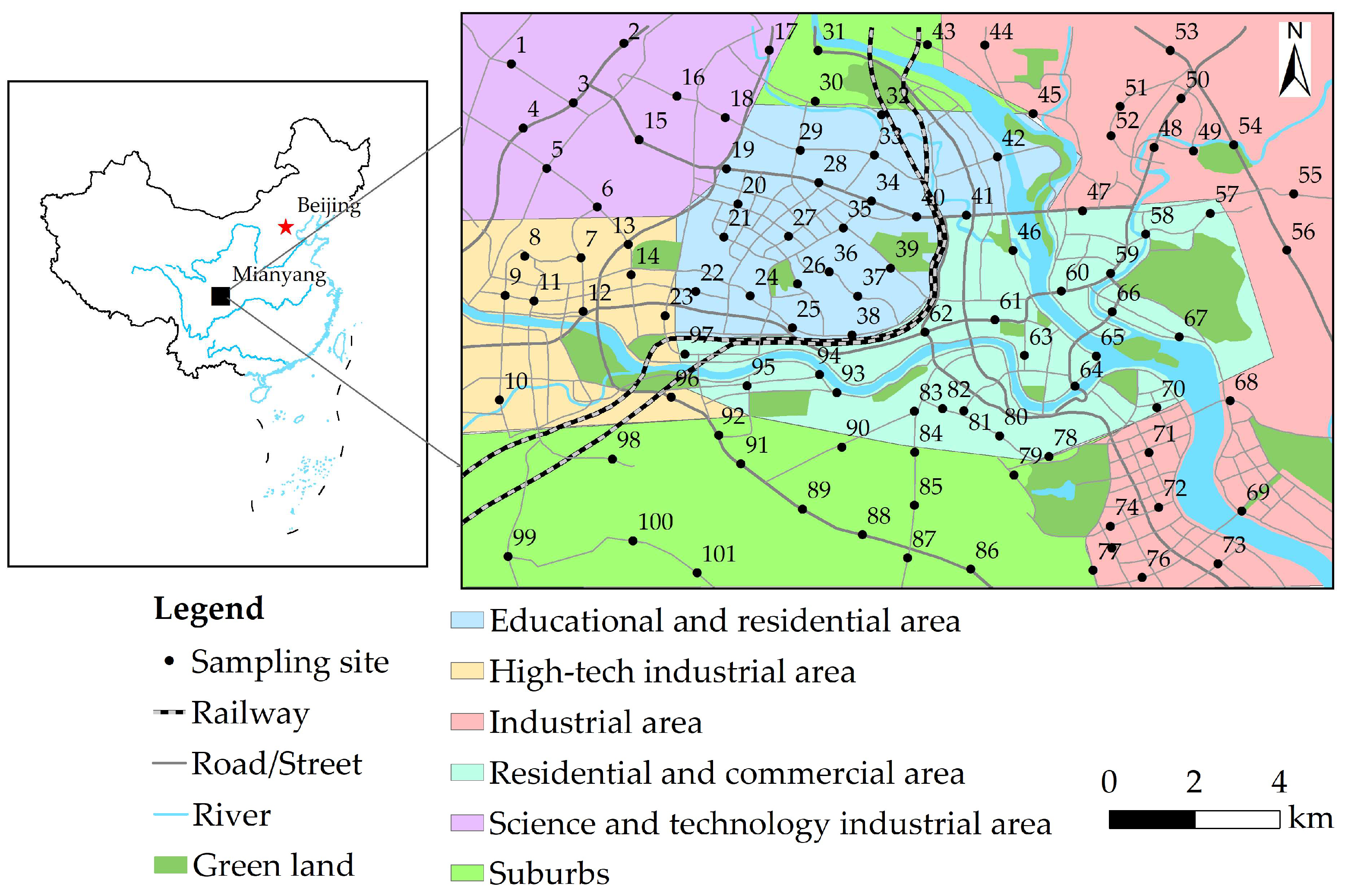
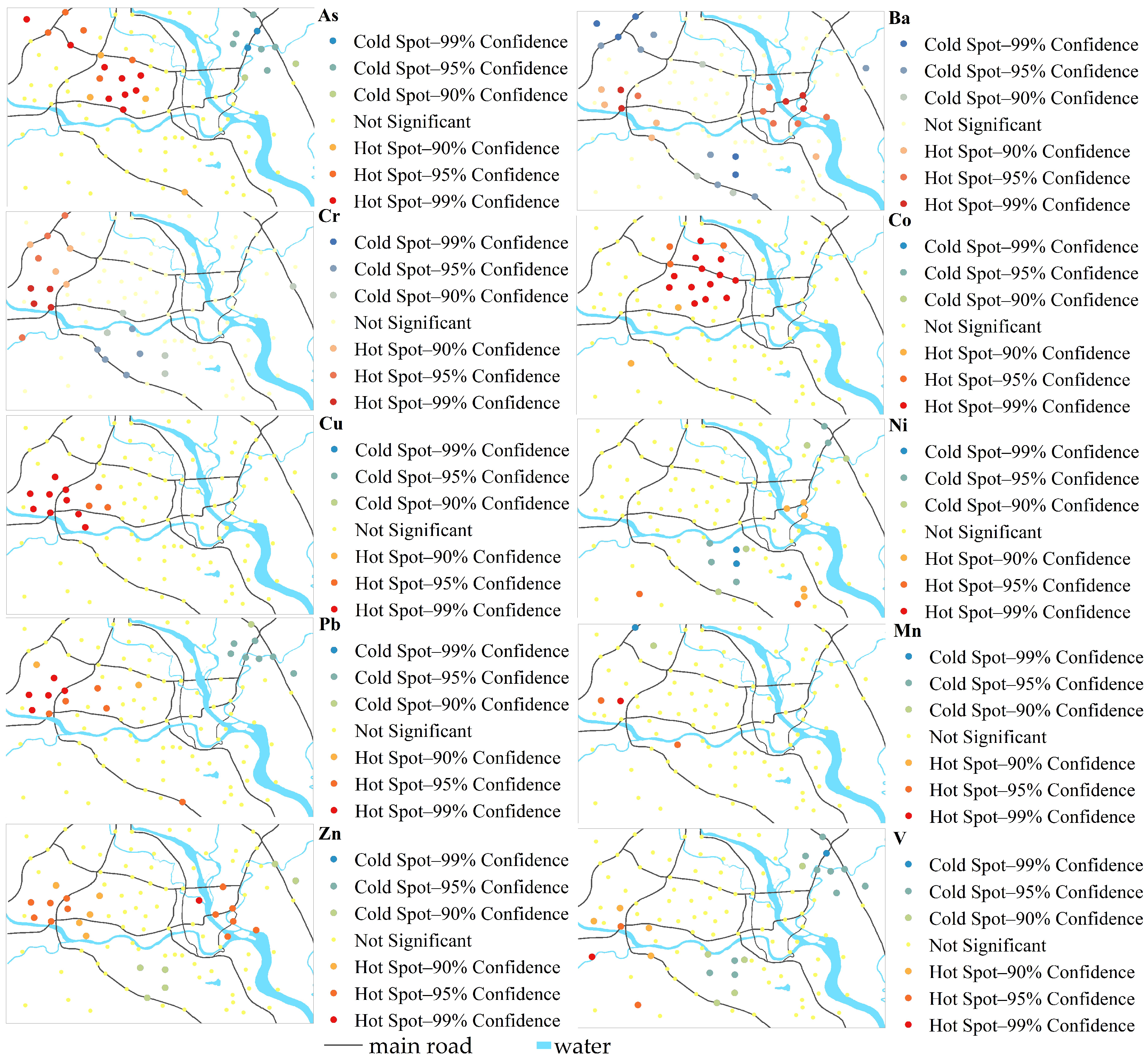
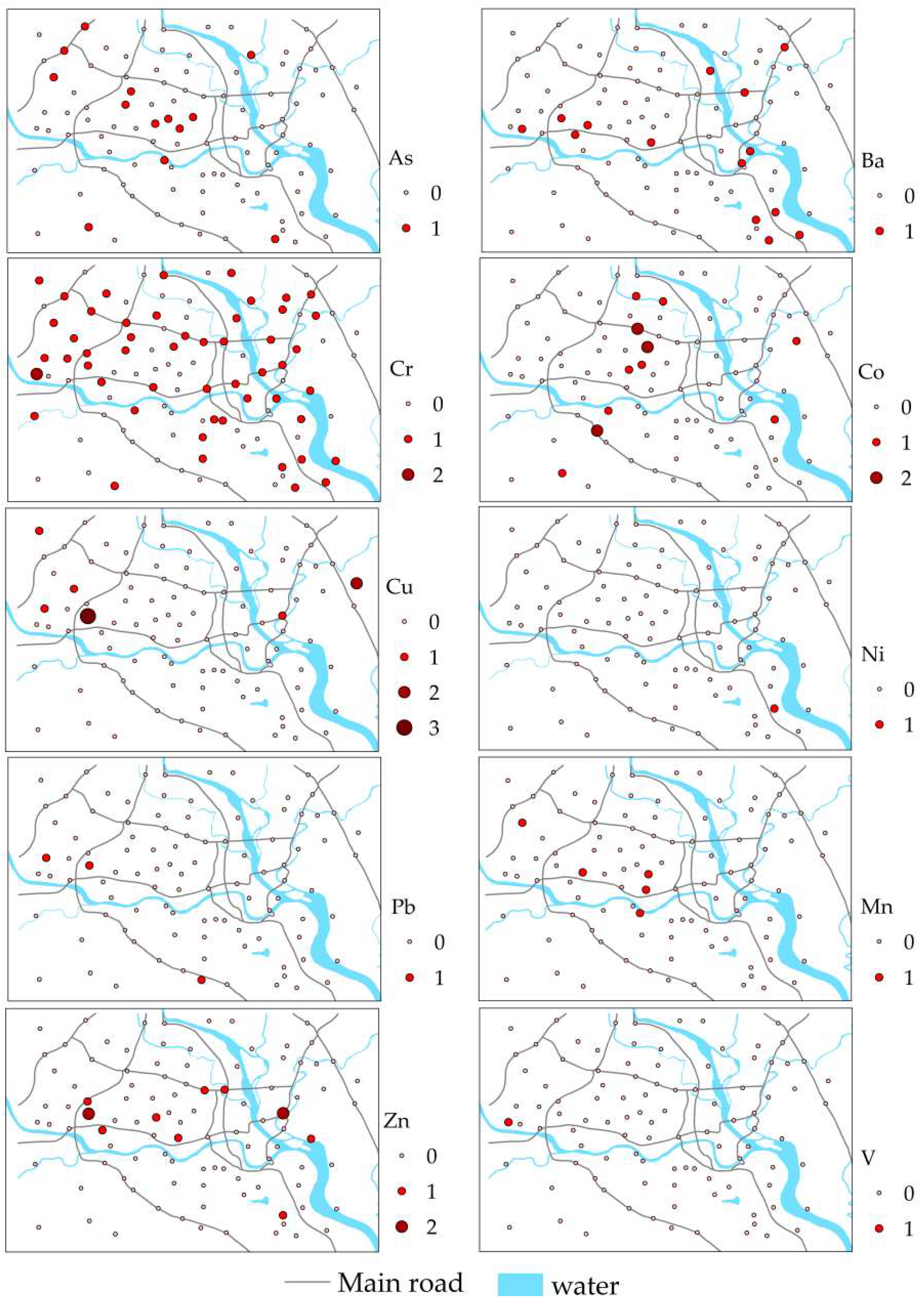
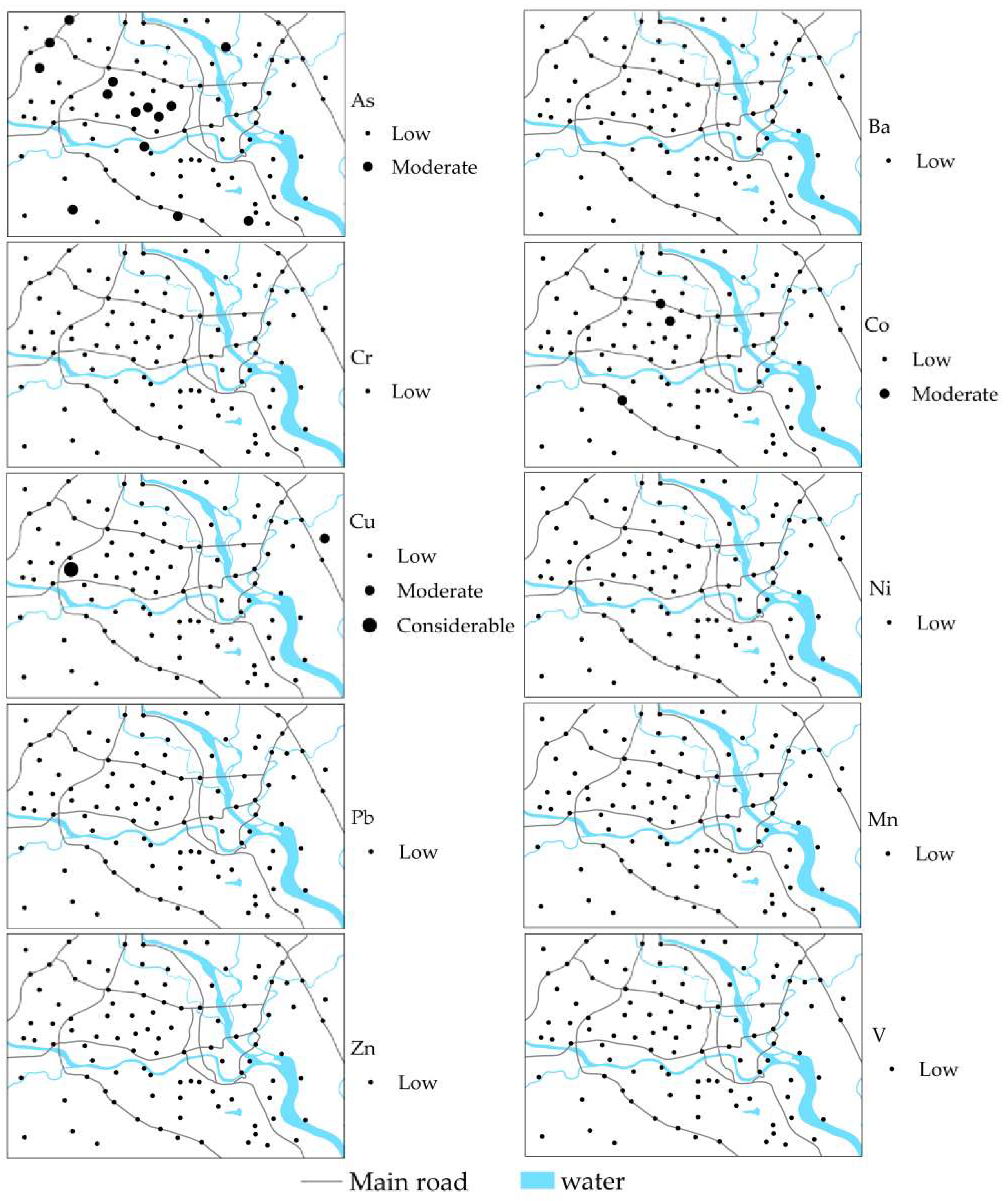
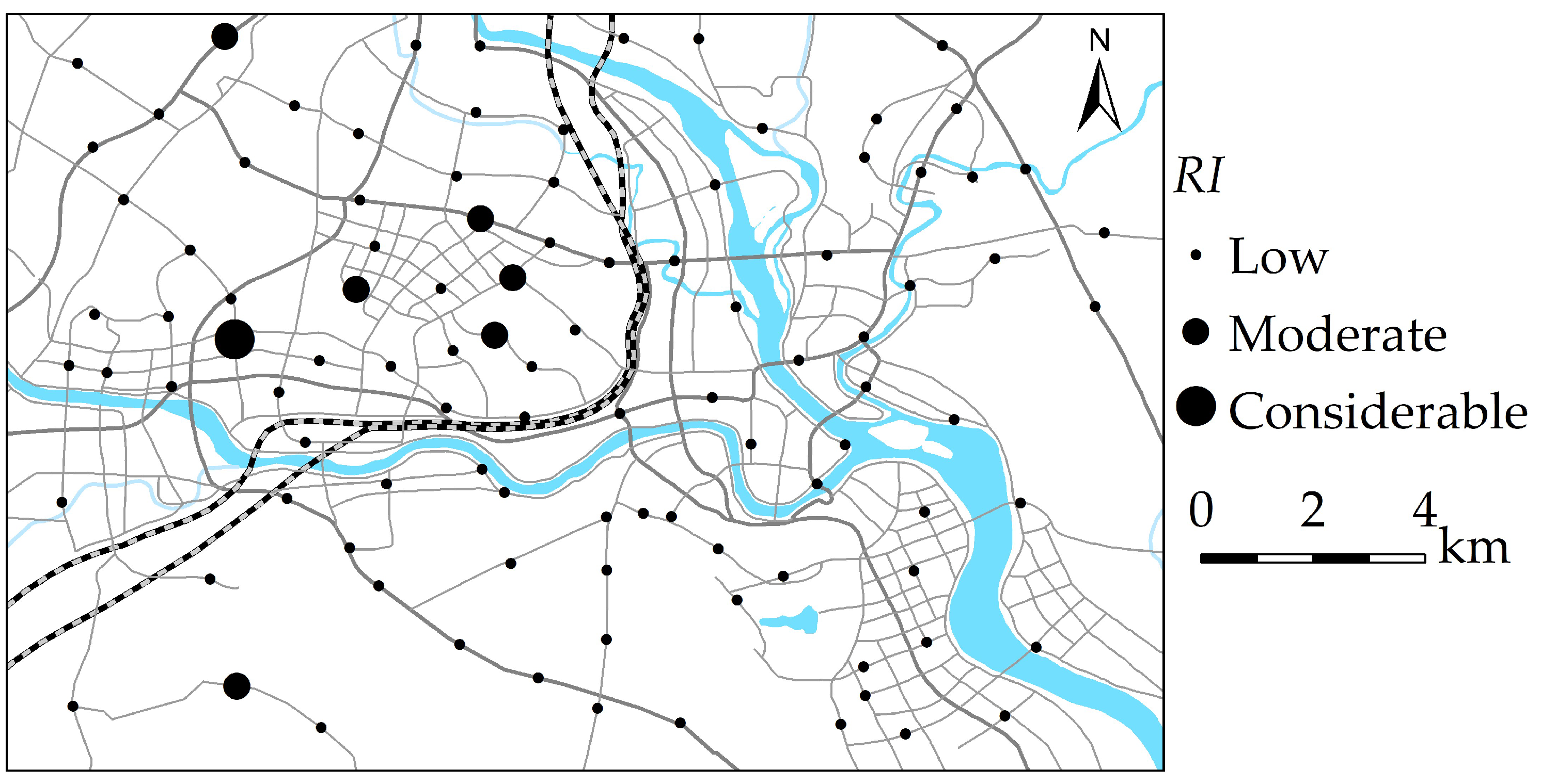
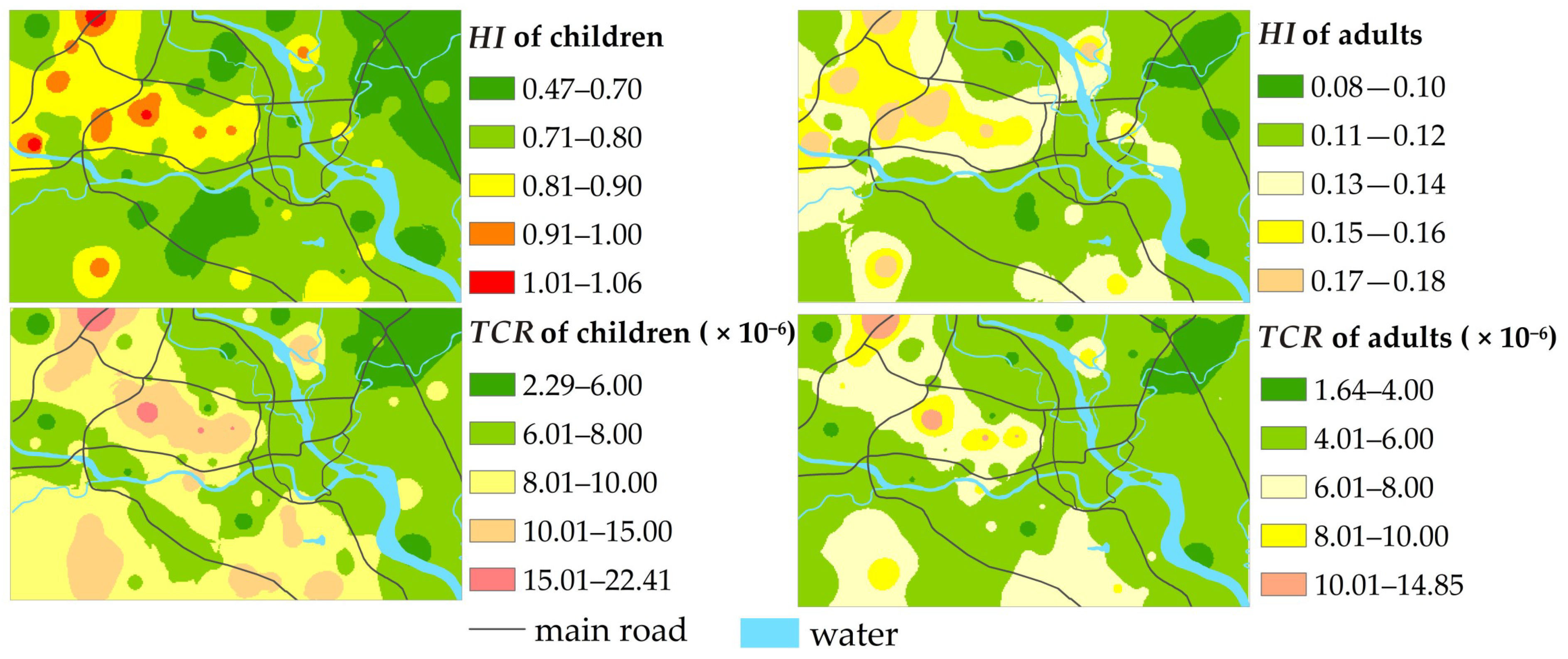
| Element | As | Ba | Cr | Co | Cu | Ni | Pb | Mn | Zn | V | 10 HMs | |
|---|---|---|---|---|---|---|---|---|---|---|---|---|
| Child | HQing | 1.86 × 10−1 | 4.31 × 10−2 | 2.10 × 10−1 | 4.67 × 10−3 | 4.32 × 10−3 | 9.04 × 10−3 | 4.07 × 10−2 | 7.31 × 10−2 | 1.67 × 10−3 | 7.11 × 10−2 | |
| HQinh | 5.17 × 10−6 | 5.89 × 10−4 | 6.17 × 10−4 | 4.57 × 10−4 | 1.20 × 10−7 | 2.45 × 10−7 | 1.13 × 10−6 | 6.57 × 10−3 | 4.66 × 10−8 | 1.99 × 10−6 | ||
| HQdermal | 3.87 × 10−2 | 1.75 × 10−3 | 3.00 × 10−2 | 1.66 × 10−5 | 4.10 × 10−5 | 9.54 × 10−5 | 7.74 × 10−4 | 5.21 × 10−3 | 2.38 × 10−5 | 2.03 × 10−2 | ||
| HQ | 2.25 × 10−1 | 4.54 × 10−2 | 2.41 × 10−1 | 5.14 × 10−3 | 4.36 × 10−3 | 9.14 × 10−3 | 4.15 × 10−2 | 8.49 × 10−2 | 1.69 × 10−3 | 9.14 × 10−2 | ||
| HI | 7.49 × 10−1 | |||||||||||
| Adult | HQing | 2.89 × 10−2 | 6.69 × 10−3 | 3.27 × 10−2 | 7.25 × 10−4 | 6.71 × 10−4 | 1.40 × 10−3 | 6.33 × 10−3 | 1.14 × 10−2 | 2.59 × 10−4 | 1.10 × 10−2 | |
| HQinh | 4.23 × 10−6 | 4.82 × 10−4 | 5.04 × 10−4 | 3.73 × 10−4 | 9.82 × 10−8 | 2.01 × 10−7 | 9.25 × 10−7 | 5.38 × 10−3 | 3.81 × 10−8 | 1.62 × 10−6 | ||
| HQdermal | 7.94 × 10−3 | 3.60 × 10−4 | 6.15 × 10−3 | 3.41 × 10−6 | 8.41 × 10−6 | 1.96 × 10−5 | 1.59 × 10−4 | 1.07 × 10−3 | 4.88 × 10−6 | 4.16 × 10−3 | ||
| HQ | 3.68 × 10−2 | 7.53 × 10−3 | 3.93 × 10−2 | 1.10 × 10−3 | 6.79 × 10−4 | 1.42 × 10−3 | 6.49 × 10−3 | 1.78 × 10−2 | 2.64 × 10−4 | 1.52 × 10−2 | ||
| HI | 1.27 × 10−1 | |||||||||||
| Child | CRing | 6.69 × 10−6 | ||||||||||
| CRinh | 1.88 × 10−9 | 5.93 × 10−8 | 2.04 × 10−9 | 3.40 × 10−10 | ||||||||
| CRdermal | 1.39 × 10−6 | |||||||||||
| CR | 8.08 × 10−6 | 5.93 × 10−8 | 2.04 × 10−9 | 3.40 × 10−10 | ||||||||
| TCR | 8.15 × 10−6 | |||||||||||
| Adult | CRing | 4.16 × 10−6 | ||||||||||
| CRinh | 6.15 × 10−9 | 1.94 × 10−7 | 6.69 × 10−9 | 1.11 × 10−9 | ||||||||
| CRdermal | 1.14 × 10−6 | |||||||||||
| CR | 5.31 × 10−6 | 1.94 × 10−7 | 6.69 × 10−9 | 1.11 × 10−9 | ||||||||
| TCR | 5.51 × 10−6 |
Publisher’s Note: MDPI stays neutral with regard to jurisdictional claims in published maps and institutional affiliations. |
© 2022 by the authors. Licensee MDPI, Basel, Switzerland. This article is an open access article distributed under the terms and conditions of the Creative Commons Attribution (CC BY) license (https://creativecommons.org/licenses/by/4.0/).
Share and Cite
Du, H.; Lu, X. Contamination and Probabilistic Ecological–Health Risk of Heavy Metal(loid)s in Urban Topsoil of Mianyang, SW China. Int. J. Environ. Res. Public Health 2022, 19, 15126. https://doi.org/10.3390/ijerph192215126
Du H, Lu X. Contamination and Probabilistic Ecological–Health Risk of Heavy Metal(loid)s in Urban Topsoil of Mianyang, SW China. International Journal of Environmental Research and Public Health. 2022; 19(22):15126. https://doi.org/10.3390/ijerph192215126
Chicago/Turabian StyleDu, Huaming, and Xinwei Lu. 2022. "Contamination and Probabilistic Ecological–Health Risk of Heavy Metal(loid)s in Urban Topsoil of Mianyang, SW China" International Journal of Environmental Research and Public Health 19, no. 22: 15126. https://doi.org/10.3390/ijerph192215126
APA StyleDu, H., & Lu, X. (2022). Contamination and Probabilistic Ecological–Health Risk of Heavy Metal(loid)s in Urban Topsoil of Mianyang, SW China. International Journal of Environmental Research and Public Health, 19(22), 15126. https://doi.org/10.3390/ijerph192215126





